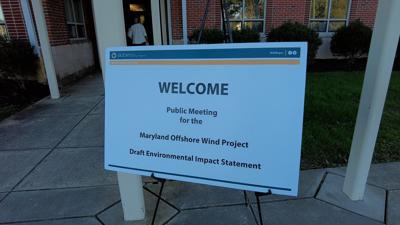OCEAN CITY, Md. -- Ocean City officials are disappointed, believing they did not have a chance to fully voice their concerns to the feds last week. The frustration stems from public meetings hosted by the Bureau of Ocean Energy Management.
Two of those meetings were in-person, one at Ocean City Elementary School and the other at Indian River High School. There were also two virtual sessions, the last of which took place on Monday night.
The meetings allow people to bring up any concerns, or praises for BOEM's Draft Environmental Impact Statement on US Wind's project proposal.
Ocean City's mayor, Rick Meehan, said the opportunity for people to speak at Ocean City Elementary did not live up to expectations.
"When you say a public hearing people believe it's an opportunity to stand up and speak before an audience, before everybody else to share opinions and to hear both pros and cons," said Meehan. "Or, to hear concerns in this case about the environmental assessment.
One reason why Meehan said he and others in Ocean City felt letdown is a late notice for how the meetings would playout.
"I think we heard late Tuesday morning, finally, what the format would be and for those that weren't there, it was really set up like a science fair," said Meehan.
Several informational posterboards were spread out with experts on offshore wind available to answer any questions. Lorena Edenfield, Maryland's Offshore Wind NEPA Coordinator for BOEM, said the environment allows for more of a discussion, rather than a dialogue.
"We view the public meetings as an opportunity to talk to the public and hear their concerns and hear their comments," said Edenfield. "Discuss with them the different components with the potential project and the alternatives."
Edenfield added it gives the public a chance to speak with scientists who are analyzing US Winds proposal.
While people were not able to speak in front of an audience, Edenfield said there are plenty of outlets for people to voice their opinions.
"They have opportunities to speak to a court stenographer if they don't want to write their comment," said Edenfield. "We welcome written comment, we welcome oral comment, we welcome things in the mail and online at regulations.gov."
With the public comment period for the draft EIS ending on November 20th, Meehan is hoping potential impacts on tourism and the economy are brought to light.
"I think and I hope that people ask those questions and BOEM will go back and require those things to be addressed by US Wind," said Meehan.
Edenfield said everything is taken into account.
"We respond to those, the things that are substantive or if there's new information presented or additional things that BOEM needs to consider, that goes into the final impact statement," said Edenfield.
BOEM's final EIS is expected to be released in the spring or early summer of 2024. Then, after at least a month of waiting, BOEM will make the final call on whether or not to approve US Winds project proposal.
Comments for the draft EIS can be submitted here.


